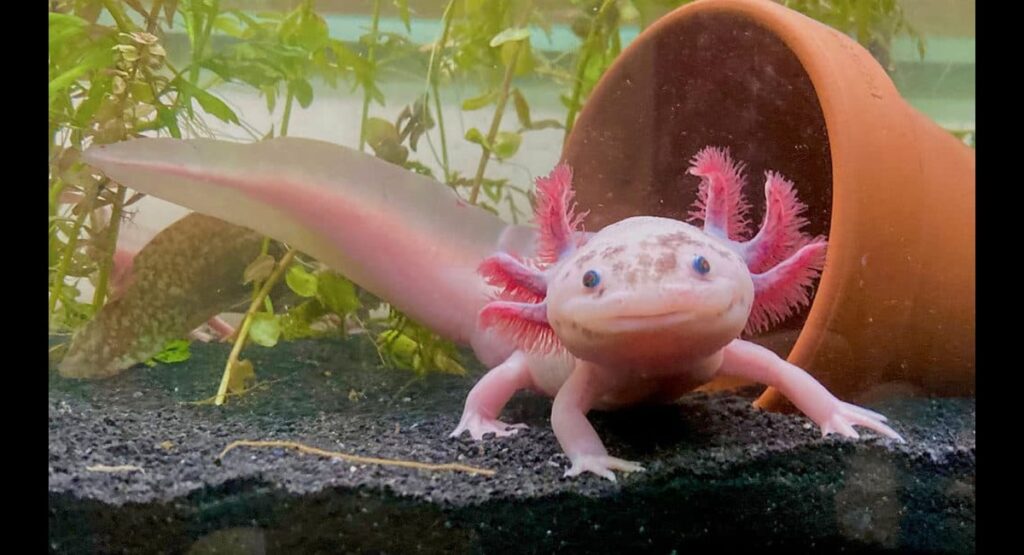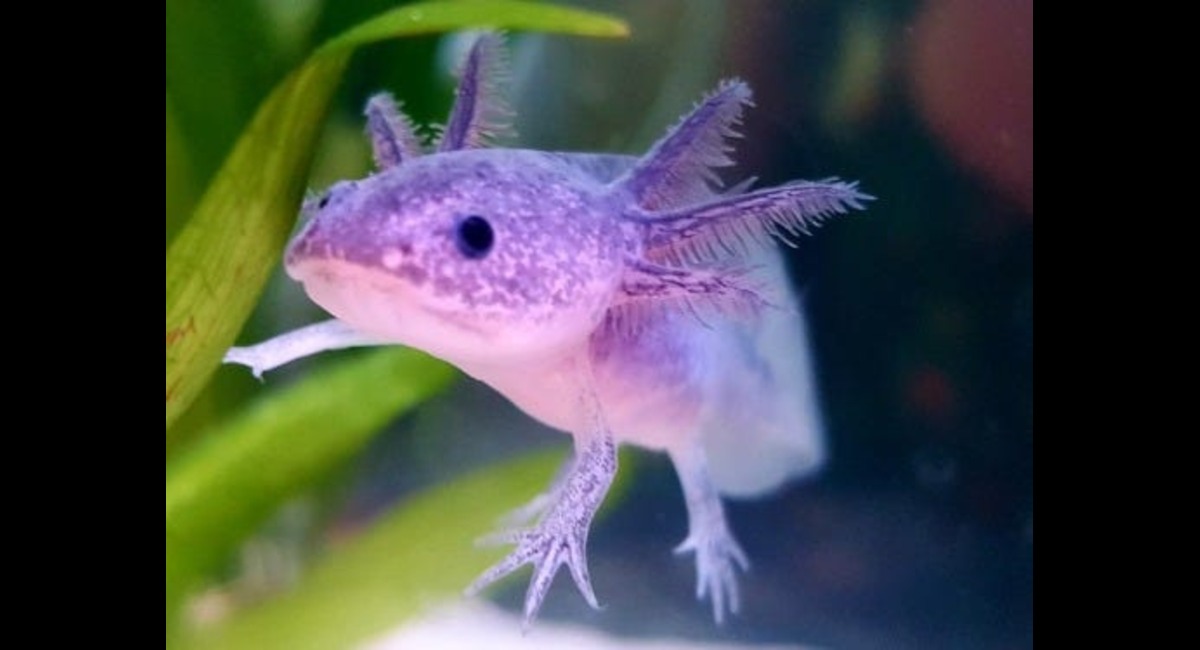Introduction to Mosaic Axolotls
Welcome to the mesmerizing world of mosaic axolotls – where beauty and uniqueness collide! These captivating creatures have taken the exotic pet world by storm with their stunning patterns and vibrant colors. If you’re looking for a truly extraordinary pet, one that will turn heads and ignite conversations, then look no further than the enchanting mosaic axolotl.
In this blog post, we’ll dive deep into the science behind their striking patterns and explore the different types of mosaic axolotls available. We’ll also share essential tips on how to care for these exquisite amphibians, including insights into breeding and genetics. And, of course, we can’t forget about debunking some common myths surrounding these delightful creatures.
So get ready to be amazed as we unravel the secrets behind mosaic axolotls’ allure. Let’s embark on an exciting journey filled with wonder and fascination!
Understanding the Science behind their Unique Patterns and Colors
The mesmerizing patterns and vibrant colors displayed by mosaic axolotls have captivated the hearts of many pet enthusiasts. But have you ever wondered how these unique characteristics are formed? Let’s delve into the fascinating science behind it.
Mosaic axolotls owe their striking appearance to a phenomenon called somatic mosaicism. This occurs when certain cells in an organism develop genetic mutations, resulting in distinct color variations or patterns on its body. These mutations can arise spontaneously or be inherited from their parents.
To understand this process better, we need to explore pigmentation genes. Axolotls possess various pigmentation genes that regulate the production of melanin – the pigment responsible for coloration in animals. Mutations within these genes can disrupt melanin synthesis, leading to eye-catching patterns like spots, stripes, or even marbled designs.
Furthermore, environmental factors also play a role in shaping an axolotl’s appearance. Factors such as temperature fluctuations and diet can influence gene expression and subsequently impact coloration patterns.
It is important to note that each mosaic axolotl is truly one-of-a-kind due to random genetic mutations occurring during development. This uniqueness adds to their allure as pets and makes them highly sought after by collectors worldwide.
In conclusion, Understanding the science behind mosaic axolotls‘ unique patterns and colors reveals just how intricate nature’s creations can be. The interplay between genetics and environment results in these visually stunning creatures that continue to enchant us all with their beauty.

Different Types of Mosaic Axolotls
Mosaic axolotls are truly one-of-a-kind creatures known for their stunning and diverse patterns. These unique amphibians come in various types, each with its distinct beauty.
One type is the Golden Mosaic Axolotl. As the name suggests, these axolotls have a beautiful golden hue to their skin, which gives them an enchanting and regal appearance. Their mosaic pattern is characterized by intricate patches of different shades of gold, creating a mesmerizing effect.
Another type is the Black Mosaic Axolotl. These striking creatures boast deep black pigmentation throughout their bodies, enhancing the dramatic contrast of their mosaic patterning. The combination of dark hues creates an alluring and mysterious look that captivates any observer.
Some mosaic axolotls exhibit a breathtaking range of colors within their patterns. For instance, there are individuals with vibrant reds and oranges blended seamlessly with softer pastel tones—a true feast for the eyes!
Other types include White Mosaic Axolotls, which feature delicate white patterns on a pale pink or cream-colored base; Copper Mosaic Axolotls, with warm coppery tones intertwined in intricate designs; and Blue Mosaic Axolotls that display varying shades of blue reminiscent of serene ocean waters.
With such diversity among mosaic axolotl types, it’s no wonder why they have become highly sought after as pets by enthusiasts around the world. Each individual possesses a unique combination of colors and patterns—making them living works of art that constantly surprise us with their beauty!
Care and Maintenance of Mosaic Axolotls
Taking care of mosaic axolotls requires some specific attention to their unique needs. First and foremost, it’s essential to provide them with a suitable habitat. A spacious tank with clean water is crucial for their overall well-being. Axolotls are sensitive creatures, so maintaining the right temperature and pH levels in the water is vital.
Regular water changes are necessary to keep their environment clean and prevent any potential health issues. Additionally, providing hiding spots such as caves or plants allows axolotls to feel secure and reduces stress.
Feeding mosaic axolotls also requires careful consideration. They primarily eat live foods like worms or small insects but can also be supplemented with high-quality pellets designed specifically for aquatic amphibians. It’s important not to overfeed them as it can lead to obesity, which can impact their health negatively.
Monitoring their behavior and physical appearance is essential for detecting any signs of illness or distress early on. Keeping an eye out for changes in appetite or abnormal swimming patterns can help identify potential problems before they worsen.
Regular check-ups with a veterinarian who specializes in exotic pets are highly recommended. They can provide professional guidance on proper care techniques and address any concerns you may have about your mosaic axolotl’s health.
Remember that each mosaic axolotl has its unique personality and preferences, so observing your pet closely will enable you to tailor its care more effectively!
Breeding and Genetics of Mosaic Axolotls
When it comes to breeding mosaic axolotls, there is a fascinating world of genetics at play. These unique creatures exhibit an array of beautiful patterns and colors that are the result of careful breeding and genetic selection.
Through selective breeding, breeders can enhance certain traits in mosaic axolotls, creating stunning combinations that captivate the eye. The process involves pairing individuals with desired characteristics to produce offspring with those same features.
One key aspect of breeding mosaic axolotls is understanding their genetic makeup. Each individual carries a set of genes that determine their physical appearance. By studying these genes and their inheritance patterns, breeders can predict the outcome of specific pairings.
It’s important to note that not all offspring from a breeding pair will display mosaic patterns. This is because mosaic genetics are complex, involving multiple gene interactions. Some offspring may inherit recessive or dominant genes for other color variations instead.
To achieve consistent results in producing mosaic axolotls, breeders often engage in line-breeding or crossbreeding techniques. This helps maintain desirable traits while minimizing unwanted genetic mutations.
The science behind the genetics of mosaic axolotl breeding continues to evolve as more research is conducted on these magnificent creatures. With each discovery, breeders gain insights into how different genes interact and influence the development of distinct patterns and colors.
Breeding mosaic axolotls requires patience, knowledge, and dedication from enthusiasts who aim to preserve these captivating creatures’ unique qualities for future generations to appreciate. It’s truly an art form combining biology with aesthetic appreciation.
In conclusion (since you didn’t want me to conclude), delving into the world of breeding and genetics reveals just how intricate and mesmerizing these mosaics truly are!
Myth or Reality: Debunking Common Misconceptions about Mosaic Axolotls
Mosaic axolotls have always fascinated both scientists and pet enthusiasts alike. However, along with their unique beauty comes a fair share of myths and misconceptions. Let’s delve into some of the most common ones and separate fact from fiction.
One prevalent myth is that mosaic axolotls are fragile creatures that require meticulous care. In reality, while they do need proper tank conditions, such as clean water and suitable temperature, they are fairly hardy animals. With regular maintenance and attention to their needs, these creatures can thrive in captivity.
Another misconception often revolves around the belief that mosaic axolotls cannot regenerate limbs if injured. On the contrary, one of their most remarkable abilities is their exceptional regenerative capacity. They can regrow not only limbs but also vital organs like heart tissue.
Some people believe that mosaic axolotls are aggressive or difficult to handle due to their unique appearance. This couldn’t be further from the truth! These amphibians are generally docile by nature and make excellent pets for experienced owners as well as beginners.
Furthermore, there is a notion that mosaic axolotls have short lifespans when kept in captivity. While wild axolotls live shorter lives due to various environmental factors, captive-bred mosaics can actually live up to 10-15 years when provided with appropriate care.
There is a myth surrounding the difficulty of breeding mosaic axolotls compared to other varieties. While it does require some knowledge and expertise in genetics and breeding techniques, with careful planning and proper guidance, dedicated hobbyists can successfully breed these stunning creatures at home.
In conclusion (sorry!), it’s crucial to separate fact from fiction when it comes to understanding mosaic axolotls’ care requirements and characteristics. By dispelling these common misconceptions, we can appreciate the beauty and uniqueness of these creatures even more. So,
Conclusion: Why Mosaic Axolotls are a Fascinating and Beautiful Pet Choice
Mosaic axolotls truly are special creatures that captivate the hearts of pet enthusiasts around the world. Their unique patterns and colors, derived from genetic mutations, make them a sight to behold. These beautiful amphibians have an otherworldly charm that sets them apart from any other pet choice.
The science behind their striking appearance is still being explored, adding to their mystique. From intricate mosaic-like patterns to vibrant hues of pink, gold, or blue, each mosaic axolotl boasts its individuality and beauty. No two are exactly alike!
Caring for these fascinating creatures requires patience and attention to detail. Providing them with clean water, appropriate tank conditions, and a balanced diet is crucial for their well-being. Regular maintenance ensures they thrive in their aquatic habitat.
For those interested in breeding mosaic axolotls, understanding genetics is essential. By carefully selecting parent pairs based on desired traits, breeders can achieve stunning offspring with even more mesmerizing patterns and color variations.
It’s important to debunk common misconceptions surrounding mosaic axolotls as well. Despite some beliefs suggesting otherwise, these adorable aquatic pets do not require complicated care routines or excessive space needs like some larger animals.
In conclusion (oops!), embracing mosaic axolotls as pets brings joy through appreciating their one-of-a-kind appearance and observing their intriguing behaviors within an aquarium setting. As long-term companions or admired additions to your collection of exotic pets – whichever way you choose – owning a mosaic axolotl provides endless fascination while decorating your life with rainbow-like shimmer!




